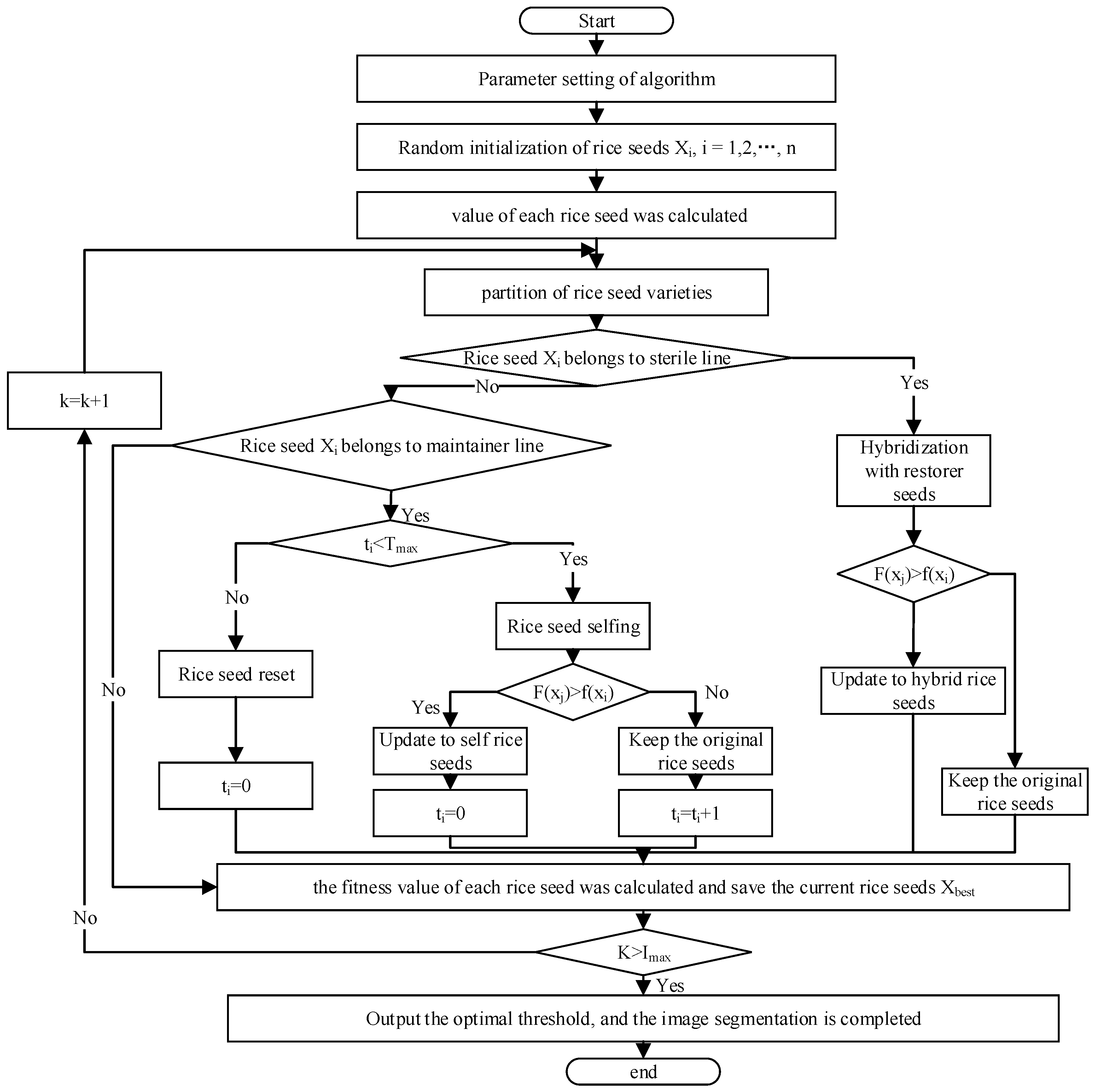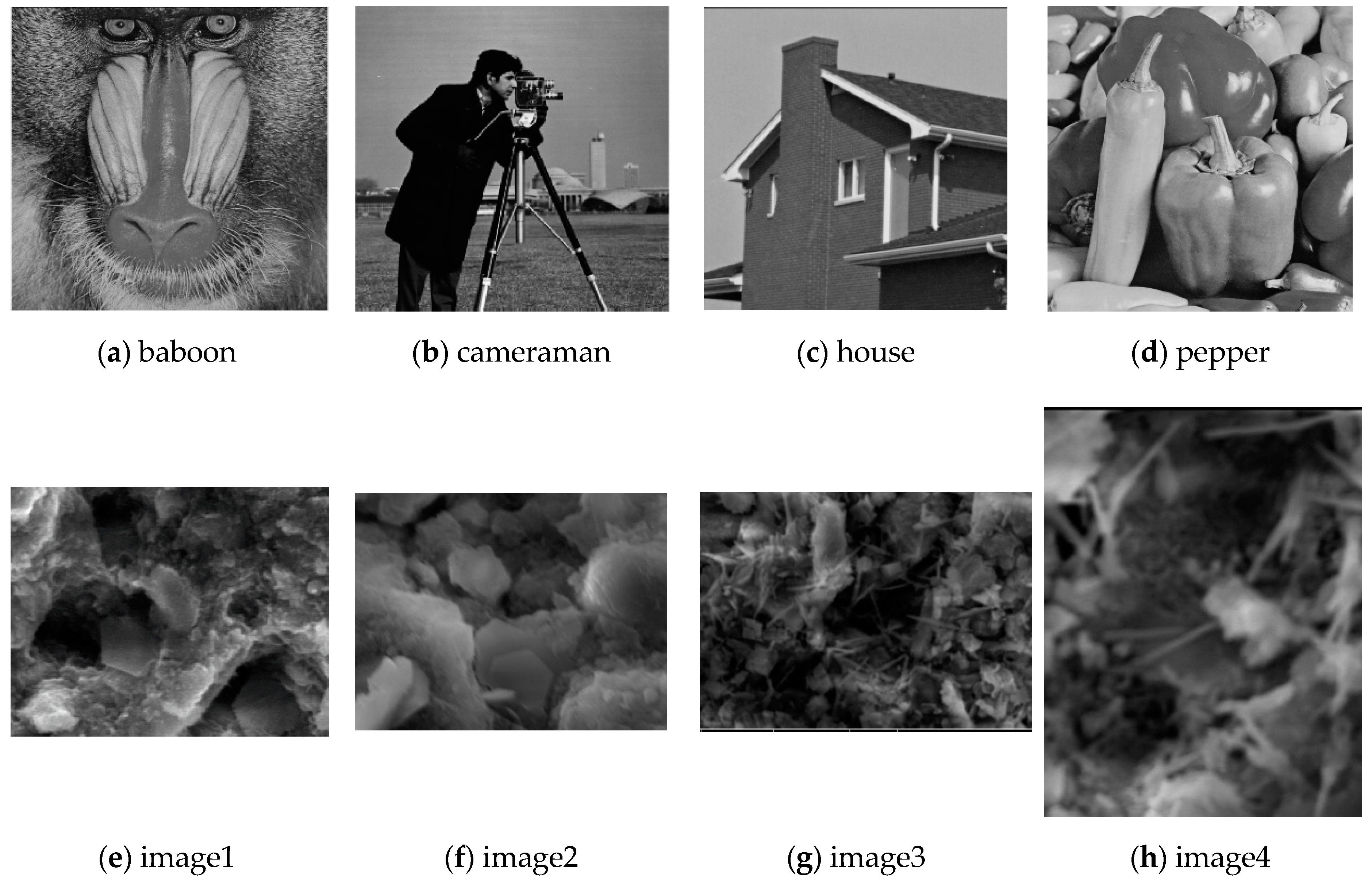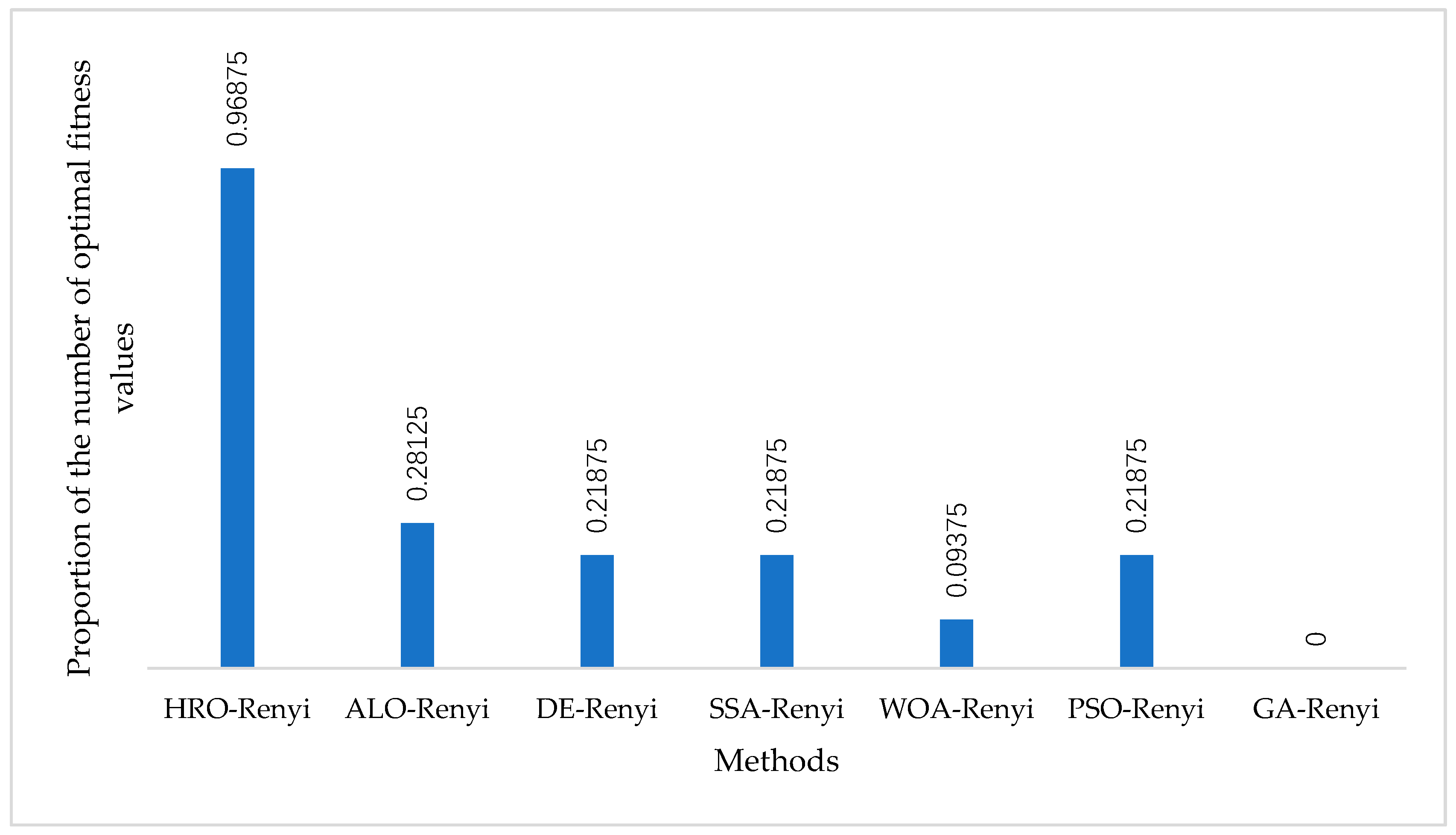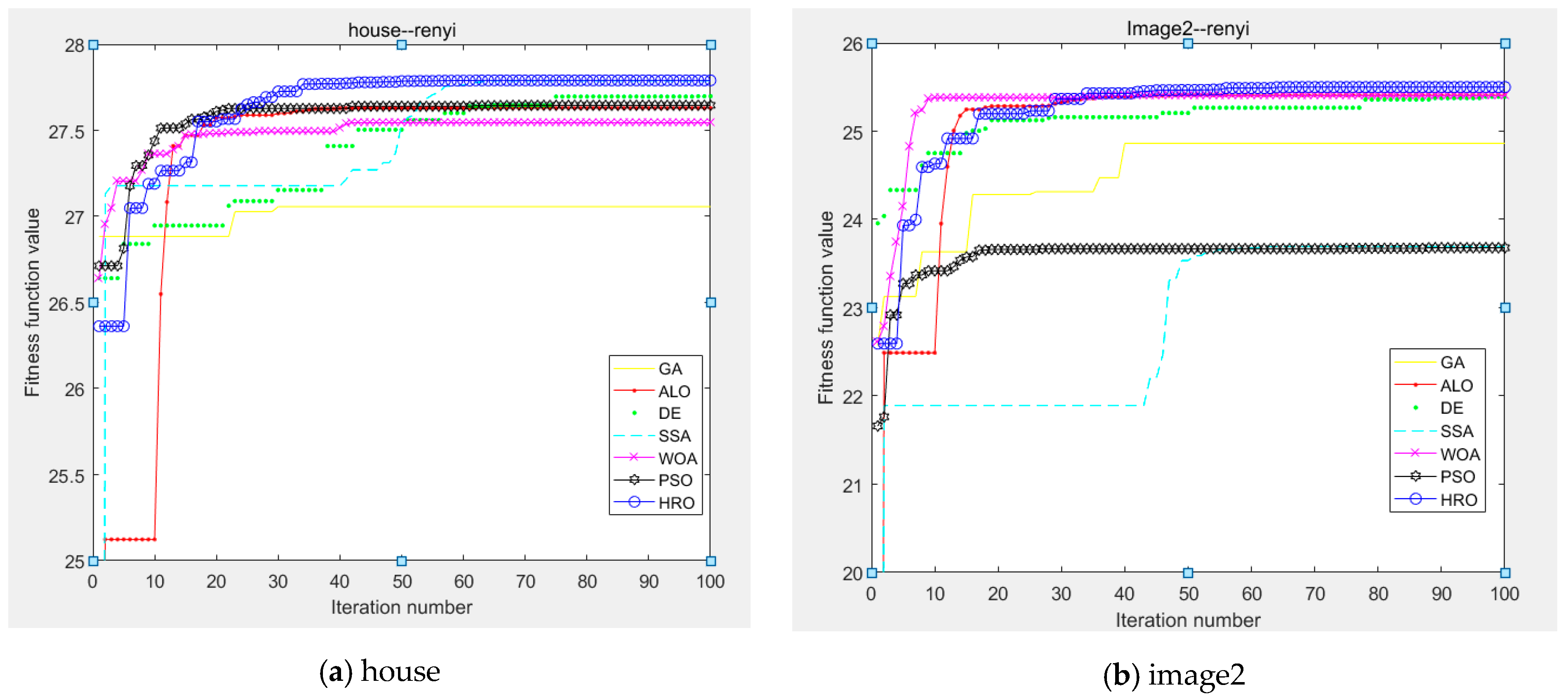Renyi’s Entropy Based Multilevel Thresholding Using a Novel Meta-Heuristics Algorithm
Abstract
1. Introduction
2. Methodological Background
2.1. Renyi’s Entropy
2.2. The Meta-Heuristics Algorithm Derived from the Breeding Mechanism of Chinese Hybrid Rice
3. Proposed Method
3.1. Idea of the Algorithm
3.2. The Procedure of the Algorithm
4. Simulation Results and Discussion
4.1. Quantitative Evaluation of Segmented Results
4.2. Visual Evaluation of the Segmented Image
5. Conclusions
Author Contributions
Funding
Conflicts of Interest
References
- Zhan, Y.; Zhang, G. An Improved OTSU Algorithm Using Histogram Accumulation Moment for Ore Segmentation. Symmetry 2019, 11, 431. [Google Scholar] [CrossRef]
- Sun, H.; Yang, X.; Gao, H. A spatially constrained shifted asymmetric Laplace mixture model for the grayscale image segmentation. Neurocomputing 2019, 331, 50–57. [Google Scholar] [CrossRef]
- Bai, X.; Wang, Y.; Liu, H.; Guo, S. Symmetry information based fuzzy clustering for infrared pedestrian segmentation. IEEE Trans. Fuzzy Syst. 2017, 26, 1946–1959. [Google Scholar] [CrossRef]
- Yeom, S. Multi-level segmentation of infrared images with region of interest extraction. Int. J. Fuzzy Log. Intell. Syst. 2016, 16, 246–253. [Google Scholar] [CrossRef]
- Bai, J.; Jiang, H.; Li, S.; Ma, X. NHL Pathological Image Classification Based on Hierarchical Local Information and GoogLeNet-Based Representations. BioMed Res. Int. 2019, 2019, 1–13. [Google Scholar] [CrossRef] [PubMed]
- Wang, G.; Li, W.; Zuluaga, M.A.; Pratt, R.; Patel, P.A.; Aertsen, M.; Doel, T.; David, A.L.; Deprest, J.; Ourselin, S.; et al. Interactive medical image segmentation using deep learning with image-specific fine tuning. IEEE Trans. Med. Imaging 2018, 37, 1562–1573. [Google Scholar] [CrossRef]
- Li, J.; Luo, W.; Wang, Z.; Fan, S. Early detection of decay on apples using hyperspectral reflectance imaging combining both principal component analysis and improved watershed segmentation method. Postharvest Biol. Technol. 2019, 149, 235–246. [Google Scholar] [CrossRef]
- Wei, Y.; Wei, L.; Ji, T.; Hu, H. A Novel Image Classification Approach for Maize Diseases Recognition. Recent Adv. Electr. Electron. Eng. 2020, 13, 331–339. [Google Scholar]
- Krish, R.P.; Fierrez, J.; Ramos, D.; Alonso-Fernandez, F.; Bigun, J. Improving automated latent fingerprint identification using extended minutia types. Inf. Fusion 2019, 50, 9–19. [Google Scholar] [CrossRef]
- Hong, G.; Chao, Z.; Lin, L.; Wenting, L. Sub-pixel extraction of laser stripe in complex background. Opto-Electron. Eng. 2019, 46, 180457. [Google Scholar] [CrossRef]
- Pham, T.X.; Siarry, H.; Oulhadj, H. Integrating fuzzy entropy clustering with an improved PSO for MRI brain image segmentation. Appl. Soft Comput. 2018, 65, 230–242. [Google Scholar] [CrossRef]
- Liu, W.; Shi, H.; He, X.; Pan, S.; Ye, Z.; Wang, Y. An application of optimized Otsu multi-threshold segmentation based on fireworks algorithm in cement SEM image. J. Algorithms Comput. Technol. 2018, 13, 1–12. [Google Scholar] [CrossRef]
- Igarashi, S.; Kawamura, M.; Watanabe, A. Analysis of cement pastes and mortars by a combination backscatter-based SEM image analysis and calculations based on the Powers model. Cem. Concr. Compos. 2004, 26, 977–985. [Google Scholar] [CrossRef]
- Otsu, N. A Threshold Selection Method from Gray-Level Histograms. IEEE Trans. Syst. Man Cybern. 1979, 9, 62–66. [Google Scholar] [CrossRef]
- Kapur, J.N. Maximum Entropy Models in Science and Engineering; John Wiley & Sons, Wiley Eastern Limited: New Delhi, India, 1989; pp. 333–334. [Google Scholar]
- Sahoo, P.; Wilkins, C.; Yeager, J. Threshold selection using Renyi’s entropy. Pattern Recognit. 1997, 30, 71–84. [Google Scholar] [CrossRef]
- Tsallis, C.; Levy, S.V.F.; Souza, A.M.C.; Maynard, R. Statistical-Mechanical Foundation of the Ubiquity of Lévy Distributions in Nature. Phys. Rev. Lett. 1995, 75, 3589–3593. [Google Scholar] [CrossRef]
- Mittal, H.; Saraswat, M. An optimum multi-level image thresholding segmentation using non-local means 2D histogram and exponential Kbest gravitational search algorithm. Eng. Appl. Artif. Intell. 2018, 71, 226–235. [Google Scholar] [CrossRef]
- Oliva, D.; Hinojosa, S.; Elaziz, M.A.; Ortega-Sánchez, N. Context based image segmentation using antlion optimization and sine cosine algorithm. Multimed. Tools Appl. 2018, 77, 25761–25797. [Google Scholar] [CrossRef]
- Wang, W.; Zhang, J.; Wu, W.; Zhou, S. An Automatic Approach for Retinal Vessel Segmentation by Multi-Scale Morphology and Seed Point Tracking. J. Med. Imaging Health Inform. 2018, 8, 262–274. [Google Scholar] [CrossRef]
- Jiang, H.; Zhao, D.; Zheng, R.; Ma, X. Construction of Pancreatic Cancer Classifier Based on SVM Optimized by Improved FOA. BioMed Res. Int. 2015, 2015, 1–12. [Google Scholar] [CrossRef]
- Tang, Z.; Srivastava, G.; Liu, S. Swarm intelligence and ant colony optimization in accounting model choices. J. Intell. Fuzzy Syst. 2020, 38, 2415–2423. [Google Scholar] [CrossRef]
- Srivastava, G.; Citulsky, E.; Tilbury, K. The Effects of Ant Colony Optimization on the Anonymization of Graphs. J. Comput. (JoC) 2016, 5, 92–101. [Google Scholar]
- Zhang, X.; Peng, J.; Hu, H.; Lin, K.-C.; Wang, J. Target attraction-based ant colony algorithm for mobile robots in rescue missions. Int. J. Model. Identif. Control 2012, 17, 133–142. [Google Scholar] [CrossRef]
- Reddy, G.T.; Reddy, M.P.K.; Lakshmanna, K.; Rajput, D.S.; Kaluri, R.; Srivastava, G. Hybrid genetic algorithm and a fuzzy logic classifier for heart disease diagnosis. Evol. Intell. 2019, 2019, 1–12. [Google Scholar] [CrossRef]
- Chen, W.; Hong, H.; Panahi, M.; Shahabi, H.; Wang, Y.; Shirzadi, A.; Pirasteh, S.; Alesheikh, A.A.; Khosravi, K.; Panahi, S.; et al. Spatial Prediction of Landslide Susceptibility Using GIS-Based Data Mining Techniques of ANFIS with Whale Optimization Algorithm (WOA) and Grey Wolf Optimizer (GWO). Appl. Sci. 2019, 9, 3755. [Google Scholar] [CrossRef]
- Strumberger, I.; Bacanin, N.; Tuba, M.; Tuba, E. Resource Scheduling in Cloud Computing Based on a Hybridized Whale Optimization Algorithm. Appl. Sci. 2019, 9, 4893. [Google Scholar] [CrossRef]
- Moayedi, H.; Kalantar, B.; Foong, L.K.; Bui, D.T.; Motevalli, A. Application of Three Metaheuristic Techniques in Simulation of Concrete Slump. Appl. Sci. 2019, 9, 4340. [Google Scholar] [CrossRef]
- Lang, C.; Jia, H. Kapur’s Entropy for Color Image Segmentation Based on a Hybrid Whale Optimization Algorithm. Entropy 2019, 21, 318. [Google Scholar] [CrossRef]
- Borjigin, S.; Sahoo, P.K. Color image segmentation based on multi-level Tsallis–Havrda–Charvát entropy and 2D histogram using PSO algorithms. Pattern Recognit. 2019, 92, 107–118. [Google Scholar] [CrossRef]
- Qin, J.; Shen, X.; Mei, F.; Fang, Z. An Otsu multi-thresholds segmentation algorithm based on improved ACO. J. Supercomput. 2018, 75, 955–967. [Google Scholar] [CrossRef]
- Kandhway, P.; Bhandari, A.K. A Water Cycle Algorithm-Based Multilevel Thresholding System for Color Image Segmentation Using Masi Entropy. Circuits Syst. Signal Process. 2018, 38, 3058–3106. [Google Scholar] [CrossRef]
- Suresh, S.; Lal, S. An efficient cuckoo search algorithm based multilevel thresholding for segmentation of satellite images using different objective functions. Expert Syst. Appl. 2016, 58, 184–209. [Google Scholar] [CrossRef]
- Elaziz, M.A.; Lu, S. Many-objectives multilevel thresholding image segmentation using knee evolutionary algorithm. Expert Syst. Appl. 2019, 125, 305–316. [Google Scholar] [CrossRef]
- Tarkhaneh, O.; Shen, H. An adaptive differential evolution algorithm to optimal multi-level thresholding for MRI brain image segmentation. Expert Syst. Appl. 2019, 138, 112820. [Google Scholar] [CrossRef]
- Dhar, S.; Kundu, M.K. A novel method for image thresholding using interval type-2 fuzzy set and Bat algorithm. Appl. Soft Comput. 2018, 63, 154–166. [Google Scholar] [CrossRef]
- Ye, Z.; Ma, L.; Chen, H. A hybrid rice optimization algorithm. In Proceedings of the 2016 11th International Conference on Computer Science & Education (ICCSE); Institute of Electrical and Electronics Engineers (IEEE), Nagoya, Japan, 23–25 August 2016; pp. 169–174. [Google Scholar]
- Zhang, X.; Ye, Z.; Yan, L.; Wang, C.; Wang, R. Security Situation Prediction based on Hybrid Rice Optimization Algorithm and Back Propagation Neural Network. In Proceedings of the 2018 IEEE 4th International Symposium on Wireless Systems within the International Conferences on Intelligent Data Acquisition and Advanced Computing Systems (IDAACS-SWS); Institute of Electrical and Electronics Engineers (IEEE), Lviv, Ukraine, 20–21 September 2018; pp. 73–77. [Google Scholar]
- Whitley, D. A Genetic Algorithm Tutorial. Stat. Comput. 1994, 4, 65–85. [Google Scholar] [CrossRef]
- Kennedy, J.; Eberhart, R. Particle swarm optimization. In Proceedings of the ICNN’95-International Conference on Neural Networks, Perth, Australia, 27 November–1 December 1995; pp. 1942–1948. [Google Scholar]
- Storn, R.; Price, K. Differential Evolution—A Simple and Efficient Heuristic for global Optimization over Continuous Spaces. J. Glob. Optim. 1997, 11, 341–359. [Google Scholar] [CrossRef]
- Mirjalili, S. The Ant Lion Optimizer. Adv. Eng. Softw. 2015, 83, 80–98. [Google Scholar] [CrossRef]
- Mirjalili, S.; Lewis, A. The Whale Optimization Algorithm. Adv. Eng. Softw. 2016, 95, 51–67. [Google Scholar] [CrossRef]
- Mirjalili, S.; Gandomi, A.H.; Mirjalili, S.Z.; Saremi, S.; Faris, H.; Mirjalili, S.M. Salp Swarm Algorithm: A bio-inspired optimizer for engineering design problems. Adv. Eng. Softw. 2017, 114, 163–191. [Google Scholar] [CrossRef]







| Algorithm | Parameter Setting | Value | Reference |
|---|---|---|---|
| HRO | 30 | [37] | |
| GA | pc | 0.8 | [39] |
| pm | 0.1 | ||
| PSO | c1 | 2 | [40] |
| c2 | 2 | ||
| v | [−6, 6] | ||
| DE | fr | 0.1 | [41] |
| cr | 0.6 | ||
| WOA | a1 | [0, 2] | [43] |
| a2 | [−2, −1] | ||
| R1 | rand | ||
| R2 | rand | ||
| SSA | C2 | rand | [44] |
| C3 | rand | ||
| ALO | / | / | [42] |
| Test Image | k | HRO-Renyi | ALO-Renyi | DE-Renyi | SSA-Renyi | WOA-Renyi | PSO-Renyi | GA-Renyi |
|---|---|---|---|---|---|---|---|---|
| baboon | 2 | 11.4686 | 11.4686 | 11.4686 | 11.4684 | 11.4686 | 11.4686 | 11.468 |
| 4 | 16.5897 | 16.588 | 16.5874 | 16.5779 | 16.5791 | 16.5854 | 16.5549 | |
| 6 | 21.0589 | 21.0585 | 21.0371 | 21.0303 | 20.9759 | 21.053 | 20.8251 | |
| 8 | 24.8839 | 24.4965 | 24.7552 | 24.3798 | 24.6572 | 24.7754 | 24.3504 | |
| cameraman | 2 | 12.4864 | 12.4864 | 12.4864 | 12.4864 | 12.4863 | 12.4864 | 12.4863 |
| 4 | 18.4057 | 18.3471 | 18.4052 | 18.3909 | 18.3975 | 18.4009 | 18.3846 | |
| 6 | 23.7795 | 23.7200 | 23.7729 | 23.7570 | 23.7473 | 23.7475 | 23.6548 | |
| 8 | 28.6612 | 28.5974 | 28.6348 | 28.6437 | 28.5839 | 28.6417 | 28.3456 | |
| house | 2 | 11.8064 | 11.8064 | 11.8064 | 11.8064 | 11.80616 | 11.8064 | 11.80631 |
| 4 | 17.3329 | 17.3329 | 17.33224 | 17.3329 | 17.32379 | 17.33291 | 17.30065 | |
| 6 | 22.0218 | 22.02141 | 22.00228 | 22.01171 | 21.97924 | 22.01973 | 21.89545 | |
| 8 | 26.1522 | 25.69837 | 26.0066 | 25.33308 | 26.04371 | 25.76974 | 25.77073 | |
| pepper | 2 | 12.5218 | 12.5218 | 12.5218 | 12.5218 | 12.5218 | 12.5218 | 12.5217 |
| 4 | 18.3199 | 18.3199 | 18.3194 | 18.3178 | 18.3185 | 18.3198 | 18.3047 | |
| 6 | 23.4910 | 23.4909 | 23.4846 | 23.4854 | 23.463 | 23.4888 | 23.3293 | |
| 8 | 28.0391 | 27.9952 | 28.0121 | 27.9978 | 27.9937 | 28.0289 | 27.6193 | |
| image1 | 2 | 12.5460 | 12.5458 | 12.5460 | 12.5456 | 12.5458 | 12.5459 | 12.5456 |
| 4 | 18.7229 | 18.7222 | 18.7223 | 18.7208 | 18.7188 | 18.7217 | 18.6988 | |
| 6 | 24.0641 | 24.0617 | 24.0522 | 24.0527 | 24.0385 | 24.0604 | 23.9386 | |
| 8 | 28.8219 | 28.8078 | 28.7710 | 28.6861 | 28.7250 | 28.7597 | 28.4813 | |
| image2 | 2 | 11.3539 | 11.3539 | 11.3539 | 11.3539 | 11.3521 | 11.3539 | 11.3533 |
| 4 | 16.6878 | 16.6855 | 16.6869 | 16.6874 | 16.6810 | 16.6841 | 16.6592 | |
| 6 | 21.4421 | 21.2219 | 21.3739 | 21.1208 | 21.3276 | 21.4302 | 21.1757 | |
| 8 | 25.4777 | 25.2385 | 25.2277 | 24.4738 | 25.2488 | 24.8811 | 24.9524 | |
| image3 | 2 | 11.3417 | 11.3417 | 11.3417 | 11.3417 | 11.3413 | 11.3417 | 11.3416 |
| 4 | 16.6759 | 16.6759 | 16.6741 | 16.6757 | 16.6687 | 16.6757 | 16.6499 | |
| 6 | 21.0103 | 20.8263 | 21.0759 | 20.7750 | 21.0994 | 20.7757 | 20.9413 | |
| 8 | 25.1005 | 25.0947 | 25.0833 | 25.0896 | 25.0238 | 25.0923 | 24.8731 | |
| image4 | 2 | 11.8064 | 11.8064 | 11.8064 | 11.8064 | 11.8063 | 11.8064 | 11.8063 |
| 4 | 17.3329 | 17.3329 | 17.3327 | 17.3329 | 17.3277 | 17.3329 | 17.3053 | |
| 6 | 22.0218 | 21.9362 | 22.0032 | 22.0133 | 21.9971 | 22.0198 | 21.8579 | |
| 8 | 26.1522 | 25.7859 | 25.9856 | 25.4901 | 26.0444 | 25.7597 | 25.7633 |
| T × 10 st Imag × 10 | k | HRO-R × 10 nyi | ALO-R × 10 nyi | D × 10 -R × 10 nyi | SSA-R × 10 nyi | WOA-R × 10 nyi | PSO-R × 10 nyi | GA-R × 10 nyi |
|---|---|---|---|---|---|---|---|---|
| baboon | 2 | 0.00 × 10+00 | 0.00 × 10+00 | 0.00 × 10+00 | 4.00 × 10−04 | 2.00 × 10−04 | 0.00 × 10+00 | 7.00 × 10−04 |
| 4 | 2.21 × 10−03 | 6.00 × 10−03 | 3.10 × 10−03 | 1.24 × 10−02 | 8.80 × 10−03 | 8.50 × 10−03 | 1.63 × 10−02 | |
| 6 | 1.01 × 10−02 | 1.01 × 10−02 | 1.62 × 10−02 | 4.95 × 10−02 | 8.14 × 10−02 | 9.60 × 10−03 | 1.10 × 10−01 | |
| 8 | 6.31 × 10−03 | 7.66 × 10−01 | 7.97 × 10−02 | 7.66 × 10−01 | 1.69 × 10−01 | 3.75 × 10−01 | 1.97 × 10−01 | |
| cam × 10 raman | 2 | 3.65 × 10−15 | 3.59 × 10−15 | 3.59 × 10−15 | 3.59 × 10−15 | 3.65 × 10−04 | 3.59 × 10−15 | 2.13 × 10−04 |
| 4 | 2.53 × 10−04 | 1.05 × 10−01 | 1.11 × 10−03 | 5.86 ×10 −02 | 1.02 × 10−02 | 3.48 × 10−02 | 1.49 × 10−02 | |
| 6 | 1.47 × 10−04 | 9.63 × 10−02 | 5.56 × 10−03 | 4.88 × 10−02 | 4.60 × 10−02 | 6.09 × 10−02 | 5.31 × 10−02 | |
| 8 | 9.16 × 10−04 | 9.61 × 10−02 | 1.48 × 10−02 | 4.56 × 10−02 | 6.76 × 10−02 | 4.36 × 10−02 | 1.29 × 10−01 | |
| hous × 10 | 2 | 3.65 × 10−15 | 3.65 × 10−15 | 3.65 × 10−15 | 3.65 × 10−15 | 5.67 × 10−04 | 3.65 × 10−15 | 2.48 × 10−04 |
| 4 | 3.91 × 10−06 | 0.00 × 10+00 | 1.14 × 10−03 | 1.27 × 10−05 | 1.21 × 10−02 | 1.23 × 10−04 | 2.39 × 10−02 | |
| 6 | 8.07 × 10−04 | 8.85 × 10−04 | 2.74 × 10−02 | 2.10 × 10−02 | 7.33 × 10−02 | 1.52 × 10−03 | 6.43 × 10−02 | |
| 8 | 1.25 × 10−02 | 7.94 × 10−01 | 1.09 × 10−01 | 8.38 × 10−01 | 7.11 × 10−02 | 7.27 × 10−01 | 1.36 × 10−01 | |
| p × 10 pp × 10 r | 2 | 0.00 × 10+00 | 0.00 × 10+00 | 0.00 × 10+00 | 0.00 × 10+00 | 0.00 × 10+00 | 0.00 × 10+00 | 5.00 × 10−04 |
| 4 | 0.00 × 10+00 | 0.00 × 10+00 | 1.70 × 10−03 | 6.80 × 10−03 | 1.50 × 10−03 | 2.00 × 10−04 | 1.04 × 10−02 | |
| 6 | 8.44 × 10−05 | 3.00 × 10−04 | 5.10 × 10−03 | 2.94 × 10−02 | 2.41 × 10−02 | 1.20 × 10−03 | 7.44 × 10−02 | |
| 8 | 7.31 × 10−04 | 3.02 × 10−01 | 1.47 × 10−02 | 6.93 × 10−02 | 4.88 × 10−02 | 3.90 × 10−03 | 1.26 × 10−01 | |
| imag × 10 1 | 2 | 6.07 × 10−05 | 5.48 × 10−04 | 8.97 × 10−15 | 6.54 × 10−04 | 6.72 × 10−04 | 3.39 × 10−04 | 8.99 × 10−04 |
| 4 | 0.00 × 10+00 | 1.67 × 10−03 | 1.20 × 10−03 | 2.63 × 10−03 | 3.63 × 10−03 | 1.92 × 10−03 | 1.84 × 10−02 | |
| 6 | 4.81 × 10−03 | 5.25 × 10−03 | 9.34 × 10−03 | 1.04 × 10−02 | 2.21 × 10−02 | 4.58 × 10−03 | 4.93 × 10−02 | |
| 8 | 7.13 × 10−03 | 4.31 × 10−02 | 2.72 × 10−02 | 9.33 × 10−02 | 6.17 × 10−02 | 7.83 × 10−02 | 9.49 × 10−02 | |
| imag × 10 2 | 2 | 8.97 × 10−15 | 8.97 × 10−15 | 8.97 × 10−15 | 8.97 × 10−15 | 5.75 × 10−03 | 8.97 × 10−15 | 3.95 × 10−03 |
| 4 | 5.89 × 10−03 | 1.14 × 10−02 | 4.72 × 10−03 | 6.23 × 10−03 | 1.30 × 10−02 | 8.88 × 10−03 | 1.61 × 10−02 | |
| 6 | 1.09 × 10−14 | 6.39 × 10−01 | 5.48 × 10−02 | 6.77 × 10−01 | 8.24 × 10−02 | 4.22 × 10 −02 | 1.02 × 10−01 | |
| 8 | 3.52 × 10−02 | 5.78 × 10−01 | 2.25 × 10−01 | 9.50 × 10−01 | 1.42 × 10−01 | 8.45 × 10−01 | 1.71 × 10−01 | |
| imag × 10 3 | 2 | 1.79 × 10−15 | 1.79 × 10−15 | 1.79 × 10−15 | 1.79 × 10−15 | 1.37 × 10−03 | 1.79 × 10−15 | 3.79 × 10−05 |
| 4 | 3.65 × 10−15 | 3.59 × 10−15 | 1.86 × 10−03 | 7.86 × 10−04 | 1.02 × 10−02 | 4.16 × 10−04 | 2.15 × 10−02 | |
| 6 | 1.76 × 10−01 | 1.84 × 10−01 | 6.64 × 10−02 | 1.49 × 10−01 | 1.78 × 10−02 | 1.48 × 10−01 | 9.31 × 10−02 | |
| 8 | 7.58 × 10−04 | 1.67 × 10−02 | 8.93 × 10−03 | 2.70 × 10−02 | 9.70 × 10−02 | 4.11 × 10−03 | 1.00 × 10−01 | |
| imag × 10 4 | 2 | 5.38 × 10−15 | 5.38 × 10−15 | 5.38 × 10−15 | 5.38 × 10−15 | 4.84 × 10−04 | 5.38 × 10−15 | 5.90 × 10−04 |
| 4 | 3.91 × 10−06 | 0.00 × 10+00 | 6.52 × 10−04 | 1.85 × 10−04 | 5.93 × 10−03 | 5.31 × 10−05 | 1.82 × 10−02 | |
| 6 | 8.07 × 10−04 | 4.23 × 10−01 | 2.71 × 10−02 | 2.06 × 10−02 | 3.33 × 10−02 | 1.51 × 10−03 | 7.46 × 10−02 | |
| 8 | 1.25 × 10−02 | 7.24 × 10−01 | 1.72 × 10−01 | 8.28 × 10−01 | 9.86 × 10−02 | 7.17 × 10−01 | 1.24 × 10−01 |
| Test Image | k | PNSR | SSIM | ||
|---|---|---|---|---|---|
| HRO-OTSU | HRO-Renyi | HRO-OTSU | HRO-Renyi | ||
| baboon | 2 | 6.7981 | 6.7363 | 0.3064 | 0.3046 |
| 4 | 8.7101 | 9.8992 | 0.4904 | 0.551 | |
| 6 | 13.9917 | 12.1854 | 0.6913 | 0.659 | |
| 8 | 15.084 | 14.953 | 0.7477 | 0.7657 | |
| cameraman | 2 | 6.6695 | 8.5097 | 0.4680 | 0.4088 |
| 4 | 11.9553 | 15.895 | 0.5338 | 0.5502 | |
| 6 | 12.0709 | 13.9544 | 0.5876 | 0.6126 | |
| 8 | 14.2463 | 19.6721 | 0.6179 | 0.6813 | |
| house | 2 | 6.6118 | 7.0059 | 0.4383 | 0.4045 |
| 4 | 12.2213 | 12.3194 | 0.6033 | 0.7013 | |
| 6 | 10.8699 | 12.7908 | 0.6534 | 0.6687 | |
| 8 | 15.1439 | 16.2506 | 0.7387 | 0.7747 | |
| pepper | 2 | 6.9852 | 7.3017 | 0.4342 | 0.4176 |
| 4 | 14.3867 | 11.797 | 0.5631 | 0.5484 | |
| 6 | 15.7046 | 14.2376 | 0.6296 | 0.6346 | |
| 8 | 20.5632 | 15.8249 | 0.6924 | 0.6949 | |
| image1 | 2 | 6.4293 | 11.6851 | 0.1016 | 0.0731 |
| 4 | 9.427 | 14.2248 | 0.2454 | 0.2398 | |
| 6 | 11.5935 | 17.4116 | 0.3735 | 0.3996 | |
| 8 | 13.2339 | 17.299 | 0.4871 | 0.5351 | |
| image2 | 2 | 5.9105 | 10.412 | 0.1759 | 0.0712 |
| 4 | 9.0231 | 11.7494 | 0.2733 | 0.2611 | |
| 6 | 9.8523 | 14.0487 | 0.3483 | 0.4269 | |
| 8 | 11.1423 | 14.2233 | 0.4068 | 0.5407 | |
| image3 | 2 | 5.6788 | 10.0547 | 0.124 | 0.0804 |
| 4 | 8.6725 | 11.3931 | 0.2026 | 0.1928 | |
| 6 | 9.4832 | 13.0616 | 0.2672 | 0.31 | |
| 8 | 10.0703 | 16.5418 | 0.3247 | 0.419 | |
| image4 | 2 | 6.1726 | 8.7871 | 0.1582 | 0.1142 |
| 4 | 9.073 | 11.7971 | 0.2418 | 0.2189 | |
| 6 | 11.1861 | 13.5219 | 0.3362 | 0.3522 | |
| 8 | 12.082 | 16.2838 | 0.4051 | 0.4489 | |
© 2020 by the authors. Licensee MDPI, Basel, Switzerland. This article is an open access article distributed under the terms and conditions of the Creative Commons Attribution (CC BY) license (http://creativecommons.org/licenses/by/4.0/).
Share and Cite
Liu, W.; Huang, Y.; Ye, Z.; Cai, W.; Yang, S.; Cheng, X.; Frank, I. Renyi’s Entropy Based Multilevel Thresholding Using a Novel Meta-Heuristics Algorithm. Appl. Sci. 2020, 10, 3225. https://doi.org/10.3390/app10093225
Liu W, Huang Y, Ye Z, Cai W, Yang S, Cheng X, Frank I. Renyi’s Entropy Based Multilevel Thresholding Using a Novel Meta-Heuristics Algorithm. Applied Sciences. 2020; 10(9):3225. https://doi.org/10.3390/app10093225
Chicago/Turabian StyleLiu, Wei, Yongkun Huang, Zhiwei Ye, Wencheng Cai, Shuai Yang, Xiaochun Cheng, and Ibrahim Frank. 2020. "Renyi’s Entropy Based Multilevel Thresholding Using a Novel Meta-Heuristics Algorithm" Applied Sciences 10, no. 9: 3225. https://doi.org/10.3390/app10093225
APA StyleLiu, W., Huang, Y., Ye, Z., Cai, W., Yang, S., Cheng, X., & Frank, I. (2020). Renyi’s Entropy Based Multilevel Thresholding Using a Novel Meta-Heuristics Algorithm. Applied Sciences, 10(9), 3225. https://doi.org/10.3390/app10093225







